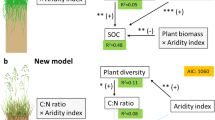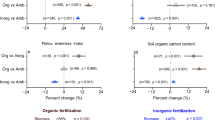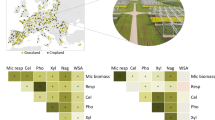Abstract
In natural ecosystems, positive effects of plant diversity on ecosystem functioning have been widely observed, yet whether this is true in cropping systems remains unclear. Here we assessed the impact of crop diversification on soil microbial diversity, soil multifunctionality (SMF) and crop yields in 155 cereal fields across a 3,000 km north–south European gradient. Overall, crop diversity showed a relatively minor effect on soil microbial diversity, SMF and yields. In contrast, the proportion of time with crop cover (including cash crops, cover crops or forage leys) during the past ten-year crop rotation had a much stronger impact. This suggests that increasing crop cover can enhance both yields and soil functioning, while also providing habitat for soil microorganisms. We found that SMF did not positively contribute to crop yields, highlighting that care must be taken to balance the provision of food with environmentally beneficial functions and services, since they do not always go hand in hand.
This is a preview of subscription content, access via your institution
Access options
Access Nature and 54 other Nature Portfolio journals
Get Nature+, our best-value online-access subscription
$29.99 / 30 days
cancel any time
Subscribe to this journal
Receive 12 digital issues and online access to articles
$119.00 per year
only $9.92 per issue
Buy this article
- Purchase on Springer Link
- Instant access to full article PDF
Prices may be subject to local taxes which are calculated during checkout






Similar content being viewed by others
Data availability
The data that support the findings of this study are available here: figshare.com/articles/dataset/Garland_et_al_Nat_Food_dataset_figshare_xlsx/10067999.
Code availability
The code used to analyse the data is available here: figshare.com/articles/online_resource/Garland_et_al_Nat_Food_R_Code_Figshare_docx/12618941.
References
Tilman, D., Balzer, C., Hill, J. & Befort, B. Global food demand and the sustainable intensitication of agriculture. Proc. Natl Acad. Sci. USA 108, 20260–20264 (2011).
Bommarco, R., Kleijn, D. & Potts, S. Ecological intensification: harnessing ecosystem services for food security. Trends Ecol. Evol. 28, 230–238 (2013).
Poppy, G. et al. Food security in a perfect storm: using the ecosystem services framework to increase understanding. Phil. Trans. R. Soc. B 369, 20120288 (2014).
Bender, S. F., Wagg, C. & van der Heijden, M. G. A. An underground revolution: biodiversity and soil ecological engineering for agricultural sustainability. Trends Ecol. Evol. 31, 440–452 (2016).
Pretty, J. Intensification for redesigned and sustainable agricultural systems. Science 362, 908 (2018).
Springmann, M. et al. Options for keeping the food system within environmental limits. Nature 562, 519–525 (2018).
Wall, D., Nielsen, U. & Six, J. Soil biodiversity and human health. Nature 528, 69–76 (2015).
Soliveres, S. et al. Biodiversity at multiple trophic levels is needed for ecosystem multifunctionality. Nature 536, 456–459 (2016).
Bardgett, R. & van der Putten, W. Belowground biodiversity and ecosystem functioning. Nature 515, 505–511 (2014).
van der Heijden, M., Bardgett, R. & van Straalen, N. The unseen majority: soil microbes as drivers of plant diversity and productivity in terrestrial ecosystems. Ecol. Lett. 11, 296–310 (2008).
Barrios, E. Soil biota, ecosystem services and land productivity. Ecol. Econ. 64, 269–285 (2007).
Wagg, C., Bender, F., Widmer, F. & van der Heijden, M. Soil biodiversity and soil community composition determine ecosystem multifunctionality. Proc. Natl Acad. Sci USA 111, 5266–5270 (2014).
Delgado-Baquerizo, M. et al. Microbial diversity drives multifunctionality in terrestrial ecosystems. Nat. Commun. 7, 10541 (2016).
Tautges, N., Sullivan, T., Reardon, C. & Burke, I. Soil microbial diversity and activity linked to crop yield and quality in a dryland organic wheat production. Appl. Soil Ecol. 108, 258–268 (2016).
Degani, E. et al. Crop rotations in a climate change scenario: short-term effects of crop diversity on resilience and ecosystem service provision under drought. Agric. Ecosyst. Environ. 285, 106625 (2019).
Philippot, L., Raaijmakers, J. M., Lemanceau, P. & Putten, W. H. V. Going back to the roots: the microbial ecology of the rhizosphere. Nat. Rev. Microbiol. 11, 789–799 (2013).
Hooper, D. et al. Interactions between aboveground and belowground biodiversity in terrestrial ecosystems: patterns, mechanisms, and feedbacks. BioScience 50, 1049–1061 (2000).
Venter, Z., Jacobs, K. & Hawkins, H. The impact of crop rotation on soil microbial diversity: a meta-analysis. Pedobiologia 59, 215–223 (2016).
Kim, N., Zabaloy, M., Guan, K. & Villamil, M. Do cover crops benefit soil microbiome? A meta-analysis of current research. Soil Biol. Biochem. 142, 107701 (2020).
Bardgett, R., Wardle, D. Aboveground–Belowground Linkages: Biotic Interactions, Ecosystem Processes, and Global Change (Oxford University Press, 2010).
Vukicevich, E., Lowery, T., Bowen, P., Úrbez-Torres, J. & Hart, M. Cover crops to increase soil microbial diversity and mitigate decline in perennial agriculture. A review. Agron. Sustainable Dev. 36, 36–48 (2016).
Bacq-Labreuil, A., Crawford, J., Mooney, S., Neal, A. & Ritz, K. Cover crops species have contrasting influence upon soil structural genesis and microbial community phenotype. Sci. Rep. 9, 7473 (2019).
Peralta, A., Sun, Y., McDaniel, M. & Lennon, J. Crop rotational diversity increases disease suppressive capacity of soil microbiomes. Ecosphere 9, e02235 (2018).
Glossary of Agriculture Definitions (United States Department of Agriculture National Agriculture Library, 2020); https://agclass.nal.usda.gov/glossary-search
de Graaff, M., Hornslein, N., Throop, H., Kardol, P. & van Diepen Effects of agricultural intensification on soil biodiversity and implications for ecosystem functioning: a meta-analysis. Adv. Agron. 155, 1–44 (2019).
Palm, C., Blanco-Canqui, H., DeClerck, F., Gatere, L. & Grace, P. Conservation agriculture and ecosystem services: an overview. Agric. Ecosyst. Environ. 187, 87–105 (2014).
Mudgal, S., et al. Environmental Impacts of Different Crop Rotations in the European Union (European Commission (DG Env), in association with Bio Intelligence Services, Warsaw University of Life Sciences, INRAE, Technological Institute of Agriculture and Biology and the University of Milan, 2010).
Fageria, N., Baligar, V. & Bailey, B. Role of cover crops in improving soil and row crop productivity. Commun. Soil Sci. Plant Anal. 36, 2733–2757 (2005).
Bianchi, F., Mikos, V., Brussaard, L., Delbaere, B. & Pulleman, M. Opportunities and limitations for functional agrobiodiversity in the European context. Environ. Sci. Policy 27, 223–231 (2013).
Direktzahlungen (Bundesamt für Landwirtschaft, 19 February 2020); https://www.blw.admin.ch/blw/de/home/instrumente/direktzahlungen.html
Delgado-Baquerizo, M. et al. Changes in belowground biodiversity during ecosystem development. Proc. Natl Acad. Sci. USA 116, 6891–6896 (2019).
Yao, H., Jiao, X. & Wu, F. Effects of continuous cucumber cropping and alternative rotations under protected cultivation on soil microbial community diversity. Plant Soil 284, 195–203 (2006).
Tiemann, L., Grandy, A., Atkinson, E., Marin-Spiotta, E. & McDaniel, M. Crop rotational diversity enhances belowground communities and functions in an agroecosystem. Ecol. Lett. 18, 761–771 (2015).
Meyer, S. et al. Biodiversity-multifunctionality relationships depend on identity and number of measured functions. Nat. Ecol. Evol. 2, 44–49 (2018).
Zhou, X., Yu, G. & Yu, F. Effects of intercropping cucumber with onion or garlic on soil enzyme activities, microbial communities and cucumber yield. Eur. J. Soil Biol. 47, 279–287 (2011).
Li, N. et al. Intercropping with potato–onion enhanced the soil microbial diversity of tomato. Microorganisms 8, 834 (2020).
Kremen, C. & Miles, A. Ecosystem services in biologically diversified versus conventional farming systems: benefits, externalities, and trade-offs. Ecol. Soc. 17, 40 (2012).
Schipanski, M. et al. A framework for evaluating ecosystem services provided by cover crops in agroecosystems. Agric. Syst. 125, 12–22 (2014).
Albizua, A., Williams, A., Hedlund, K. & Pascual, U. Crop rotations including ley and manure can promote ecosystem services in conventional farming systems. Appl. Soil Ecol. 95, 54–61 (2015).
Peltonen-Sainio, P., Rajala, A., Känkãnen, H. & Hakala, K. Improving farming systems in northern Europe. Appl. Genet. Improv. Agron. 2, 65–91 (2015).
Lu, Y., Watkins, K., Teasdale, J. & Abdul-Baki, A. Cover crops in sustainable food production. Food Rev. Int. 16, 121–157 (2000).
Kaye, J. & Quemada, M. Using cover crops to mitigate and adapt to climate change: a review. Agron. Sustain. Dev. 37, 4 (2017).
Unger, P. & Vigil, M. Cover crop effects on soil water relationships. J. Soil Water Conserv. 53, 200–207 (1998).
Bünemann, E. et al. Soil quality —a review. Soil Biol. Biochem. 120, 105–125 (2018).
Maestre, F. et al. Plant species richness and ecosystem multifunctionality in global drylands. Science 335, 214–218 (2012).
Brady, N. & Weil, R. The Nature and Properties of Soils 15th edn (Pearson Education, 2016).
Carson, J., Campbell, L., Rooney, D., Clipson, N. & Gleeson, D. Minerals in soil select distinct bacterial communities in their microhabitats. FEMS Microbial Ecol 67, 381–388 (2009).
Allison, S. & Martiny, J. Resistance, resilence, and redundancy in microbial communities. Proc. Natl Acad. Sci. USA 105, 11512–11519 (2008).
Nannipieri, P. et al. Microbial diversity and soil functions. Eur. J. Soil Sci. 54, 655–670 (2003).
McDaniel, M., Tiemann, L. & Grandy, A. Does agricultural crop diversity enhance soil microbial biomass and organic matter dynamics? A meta-analysis. Ecol. Appl. 24, 560–570 (2014).
Jousset, A., Lara, E., Wall, L. G. & Valverde, C. Secondary metabolites help biocontrol strain Pseudomonas fluorescens CHA0 to escape protozoan grazing. Appl. Environ. Microbiol. 72, 7083–7090 (2006).
George, P. et al. Divergent national-scale trends of microbial and animal biodiversity revealed across diverse temperate soil ecosystems. Nat. Commun. 10, 1107 (2019).
Jiao, S., Xu, Y., Zhang, J. & Lu, Y. Environmental filtering drives distinct continental atlases of soil archaea between dryland and wetland agricultural ecosystems. Microbiome 7, 15 (2019).
Sirami, C. et al. Increasing crop heterogeneity enhances multitrophic diversity across agricultural regions. Proc. Natl Acad. Sci. USA 116, 16442–16447 (2019).
Renard, D. & Tilman, D. National food production stabilized by crop diversity. Nature 571, 257–260 (2019).
Bowles, T. et al. Long-term evidence shows that crop-rotation diversification increases agricultural resilience to adverse growing conditions in North America. One Earth 2, 284–293 (2020).
Tamburini, G. et al. Agricultural diversification promotes multiple ecosystem services without compromising yield. Agric. Adv. 6, esaba 1715 (2020).
Lal, R. Soils and sustainable agriculture. A review. Agron. Sustain. Dev. 28, 57–64 (2008).
Griffiths, B., Faber, J. & Bloem, J. Applying soil health indicators to encourage sustainable soil use: the transition from scientific study to practical application. Sustainability 10, 3021 (2018).
Wood, S. et al. Opposing effects of different soil organic matter fractions on crop yields. Ecol. Appl. 26, 2070–2085 (2016).
Oldfield, E., Bradford, M. & Wood, S. Global meta-analysis of the relationship between soil organic matter and crop yields. SOIL 5, 15–32 (2019).
Giller, K. et al. Agricultural intensification, soil biodiversity and agroecosystem function. Appl. Soil Ecol. 6, 3–16 (1997).
Six, J., Elliott, E. T., Paustian, K. & Doran, J. W. Aggregation and soil organic matter accumulation in cultivated and native grassland soils. Soil Sci. Soc. Am. J. 62, 1367–1377 (1998).
FAL, FAW, RAC. Referenzmethoden der Eidg. landwirtschaftlichen Forschungsanstalten. 1. Bodenuntersuchung zur Düngeberatung (Zürich-Reckenholz, 1996).
Bell, C. W., et al. High-throughput fluorometric measurement of potential soil extracellular enzyme activities. J. Vis. Exp. 81, e50961 (2013).
Pell, M., Stenberg, B., Stenström, J. & Torstensson, L. Potential denitrification activity assay in soil - with or without chloramphenicol? Soil Biol. Biochem. 28, 393–398 (2002).
Berry, D., Ben Mahfoudh, K., Wagner, M. & Loy, A. Barcoded primers used in multiplex amplicon pyrosequencing bias amplification. Appl. Environ. Microbiol. 77, 7846–7849 (2011).
Gardes, M., White, T., Fortin, A., Bruns, T. & Taylor, J. Identification of indigenous and introduced symbiotic fungi in ectomycorrhizae by amplification of nuclear and mitochondrial ribosomal DNA. Can. J Bot. 69, 180–190 (1991).
Gardes, M. & Bruns, T. D. ITS primers with enhanced specificity for basidiomycetes—application to the identification of mycorrihiza and rusts. Mol. Ecol. 2, 113–118 (1993).
Fiore-Donno, A. M. et al. New barcoded primers for efficient retrieval of cercozoan sequences in high-throughput environmental diversity surveys, with emphasis on worldwide biological soil crusts. Mol. Ecol. Resour. 8, 229–239 (2018).
R Core Team. R: A Language and Environment for Statistical Computing (R Foundation for Statistical Computing, 2018); http://www.R-project.org/
Oksanen, J., et al. vegan: Community Ecology Package, 2.5-2 (2018).
FAO STAT. Crops (Food and Agriculture Organization of the United Nations, 2018); http://www.fao.org/faostat/en/#data/QC
Keel, S. et al. Loss of soil organic carbon in Swiss long-term agricultural experiments over a wide range of management practices. Agric. Ecosyst. Environ. 286, 106654 (2019).
Delgado-Baquerizo, M. et al. Decoupling of soil nutrient cycles as a function of aridity in global drylands. Nature 502, 672–676 (2013).
Rosseel, Y. lavaan: an R package for structural equation modeling. J. Stat. Softw. 48, 1–36 (2012).
Acknowledgements
We thank all the farmers and farm managers for allowing us to sample their fields and for completing our detailed questionnaires. We also thank A. Held, A. Bonvicini, S. Müller, S. Zhao, V. Somerville, A. Brugger, O. Scholz, D. Bugmann, R. Heiz, B. Seitz and M. Roser for help with both field work and laboratory analyses. The Digging Deeper project was funded through the 2015–2016 BiodivERsA COg call for research proposals, with the national funders Swiss National Science Foundation (grant 31BD30-172466), Deutsche Forschungsgemeinschaft (317895346), Swedish Research Council Formas contract 2016-0194), Ministerio de Economía y Competitividad (Digging_Deeper, reference PCIN-2016-028) and Agence Nationale de la Recherche (ANR, France, grant ANR-16-EBI3-0004-01).
Author information
Authors and Affiliations
Contributions
M.G.A.v.d.H., M.C.R., S.H., F.T.M. and L.P. designed the study and obtained research funding. G.G., A.E., S.B., F.D., P.G-P., D.S.P., C.H., S.R., A. Spor and A. Saghai contributed to data collection and analysis. G.G. and C.W. contributed to data analysis and interpretation. G.G. drafted the manuscript, with significant contributions to the writing from all coauthors. All authors commented on and approved the final manuscript.
Corresponding author
Ethics declarations
Competing interests
The authors declare no competing interests.
Additional information
Peer review information Nature Food thanks H. Kahiluoto, T. Bowles and the other, anonymous, reviewer(s) for their contribution to the peer review of this work.
Publisher’s note Springer Nature remains neutral with regard to jurisdictional claims in published maps and institutional affiliations.
Supplementary information
Supplementary Information
Supplementary Figs. 1–8, Tables 1–3, methods and references.
Rights and permissions
About this article
Cite this article
Garland, G., Edlinger, A., Banerjee, S. et al. Crop cover is more important than rotational diversity for soil multifunctionality and cereal yields in European cropping systems. Nat Food 2, 28–37 (2021). https://doi.org/10.1038/s43016-020-00210-8
Received:
Accepted:
Published:
Issue Date:
DOI: https://doi.org/10.1038/s43016-020-00210-8
This article is cited by
-
Core microbiota drive multi-functionality of the soil microbiome in the Cinnamomum camphora coppice planting
BMC Microbiology (2024)
-
Diversifying crop rotation increases food production, reduces net greenhouse gas emissions and improves soil health
Nature Communications (2024)
-
Biotic homogenization, lower soil fungal diversity and fewer rare taxa in arable soils across Europe
Nature Communications (2024)
-
Green manuring relocates microbiomes in driving the soil functionality of nitrogen cycling to obtain preferable grain yields in thirty years
Science China Life Sciences (2024)
-
River runoff causal discovery with deep reinforcement learning
Applied Intelligence (2024)



